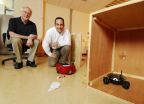"These technologically straightforward steps in livestock management could have a meaningful effect on greenhouse gas build-up, while simultaneously generating income for poor farmers," said Philip Thornton of the International Livestock Research Institute (ILRI), who co-authored the paper with ILRI senior scientist Mario Herrero.
Livestock enterprises contribute about 18 percent of the world's greenhouse gases, largely through deforestation to make room for livestock grazing and feed crops, the methane ruminant animals give off, and the nitrous oxide emitted by manure. Many worry these greenhouse gas emissions could grow due to increased livestock production to meet surging demand for meat and milk in developing countries.
Thornton and Herrero believe there are options readily available to prevent up to 417 million tons of carbon dioxide expected to be produced by livestock in tropical countries by 2030—a sum representing a savings of about 7 percent of all livestock-related global greenhouse gas emissions. Of course, if we also manage to bring down consumption of meat and milk in rich countries, the amount of carbon saved will be even greater.
Most of these reductions would have to come from the more than half a billion livestock keepers in tropical countries. But the study finds that these struggling farmers could be motivated to adopt more climate-friendly practices.
"It would be a useful incentive if these farmers were allowed to sell the reductions they achieve as credits on global carbon markets," Thornton said. "We found that at US$20 per ton—which is what carbon was trading for last week on the European Climate Exchange—poor livestock keepers in tropical countries could generate about US$1.3 billion each year in carbon revenues." Although carbon payments would not amount to a lot more income for each individual farmer (such payments might represent an increase in individual income of up to 15 percent), such payments should provide a tipping point for many smallholders considering intensifying their livestock production.
According to the ILRI study, livestock-related greenhouse gas reductions could be quickly achieved in tropical countries by modifying production practices, such as switching to more nutritious pasture grasses, supplementing diets with even small amounts of crop residues or grains, restoring degraded grazing lands, planting trees that both trap carbon and produce leaves that cows can eat, and adopting more productive breeds.
"We wanted to consider the impact in tropical countries because they are at the epicenter of a livestock revolution," said Herrero. "We expect consumption of milk and meat to roughly double in the developing world by 2050, which means it's critical to adopt sustainable approaches now that contain and reduce the negative effects of livestock production, while allowing countries to realize the benefits, such as better nutrition and higher incomes for livestock-producing households."
Herrero and Thornton said that changing diets and breeds could increase the amount of milk and meat produced by individual animals, thus reducing emissions, because farmers would require fewer animals. For example, in Latin America, they note that switching cows from natural grasslands to pastures sown with a more nutritious grass called Brachiaria can increase daily milk production and weight gain by up to three fold. This increase, they said, means fewer animals are needed to satisfy demand. In addition, Brachiaria also absorbs, or "sequesters," more carbon than degraded natural grasslands.
"Even if only about 30 percent of livestock owners in the region switch from natural grass to Brachiaria, which is what we consider a plausible adoption rate, that alone could reduce carbon dioxide emissions by about 30 million tons per year," Thornton said.
Herrero and Thornton also said that, for a given level of demand, fewer animals would be needed if more farmers supplemented grazing with feed consisting of crop residues (often called "stover"), such as the leaves and stalks of sorghum or maize plants, or with grains. In addition, they note there is the potential to boost production per animal by crossbreeding local with genetically-improved breeds, the latter of which can provide more milk and meat than traditional breeds, while emitting less methane per kilo of meat or milk produced.
Planting trees that have agricultural and feed uses, a practice known as "agroforestry," has the benefit of reducing feed costs for animals, while the trees themselves absorb carbon. Herrero and Thornton found that of the 33 million tons of carbon dioxide that could be reduced through wider use of agroforestry in livestock operations, almost two-thirds of it—72 percent—would come from the "carbon sequestration" effects of the trees.
Carols Seré, ILRI's Director General, said Thornton's and Herrero's work usefully steers the discussion of livestock's contribution to climate change from blunt criticism of the impact of farm animals to meaningful efforts to address the environmental consequences of their increased production.
"There is a tendency today to simply demonize livestock as a cause of climate change without considering their importance, particularly for poor farmers in the developing world," Seré said.
"Most of the farmers we work with have a relatively small environmental footprint," he added. "And they are intensely dependent on their animals for food, for income, and even as 'engines' to plough their fields and transport their crops. What these farmers need are technological options and economic incentives that help them intensify their production in sustainable ways. Carbon payments would be a welcome additional incentive inducing such changes in smallholder livestock production."
### About the International Livestock Research Institute (ILRI):
The Africa-based International Livestock Research Institute (ILRI) works at the crossroads of livestock and poverty, bringing high-quality science and capacity building to bear on poverty reduction and sustainable development. ILRI is one of 15 centres supported by the Consultative Group on International Agricultural Research (CGIAR). It has its headquarters in Kenya and a principal campus in Ethiopia. It also has teams working out of offices in Nigeria, Mali, Mozambique, India, Thailand, Indonesia, Laos, Vietnam and China. For more information, please visit: www.ilri.org.


